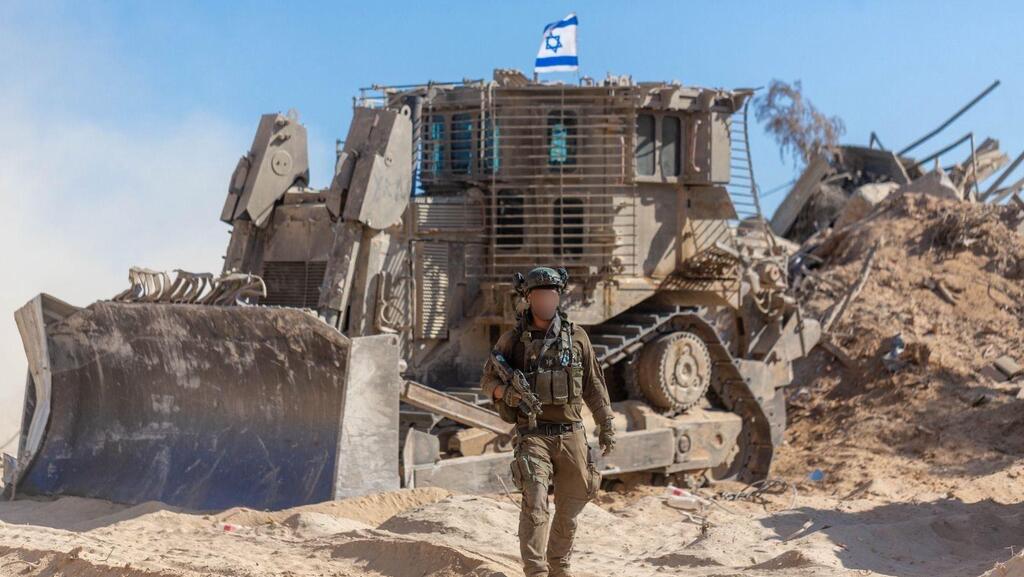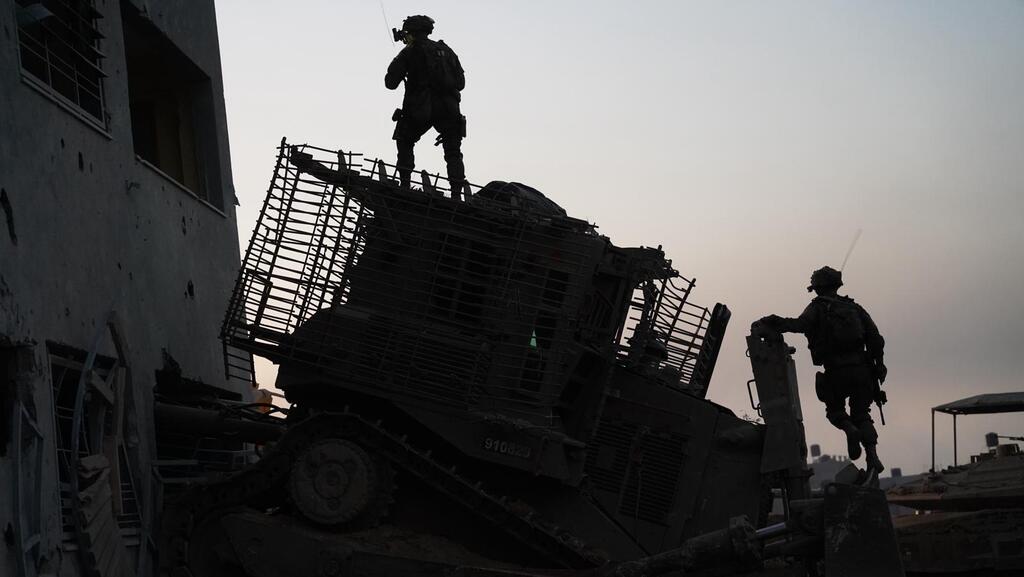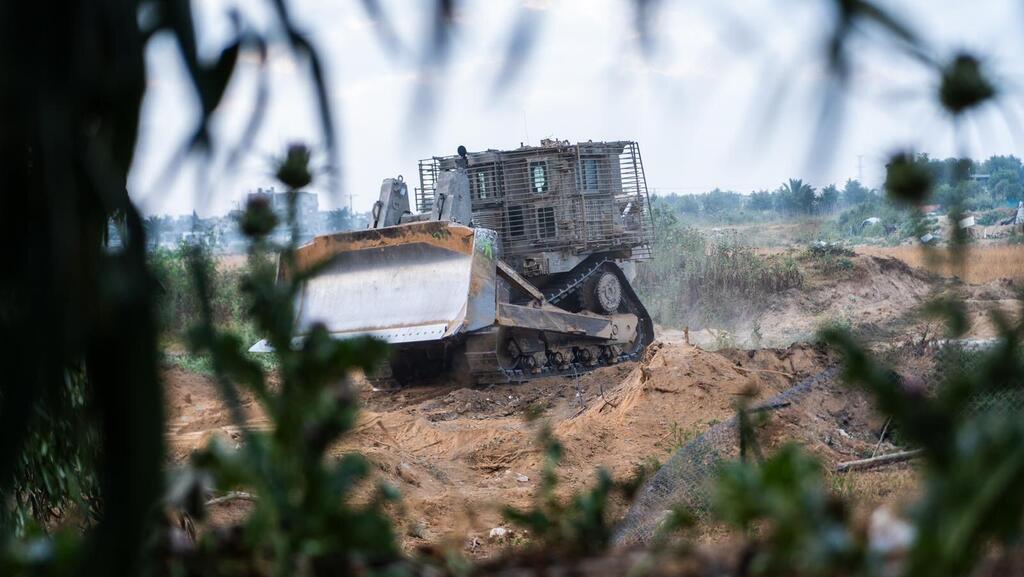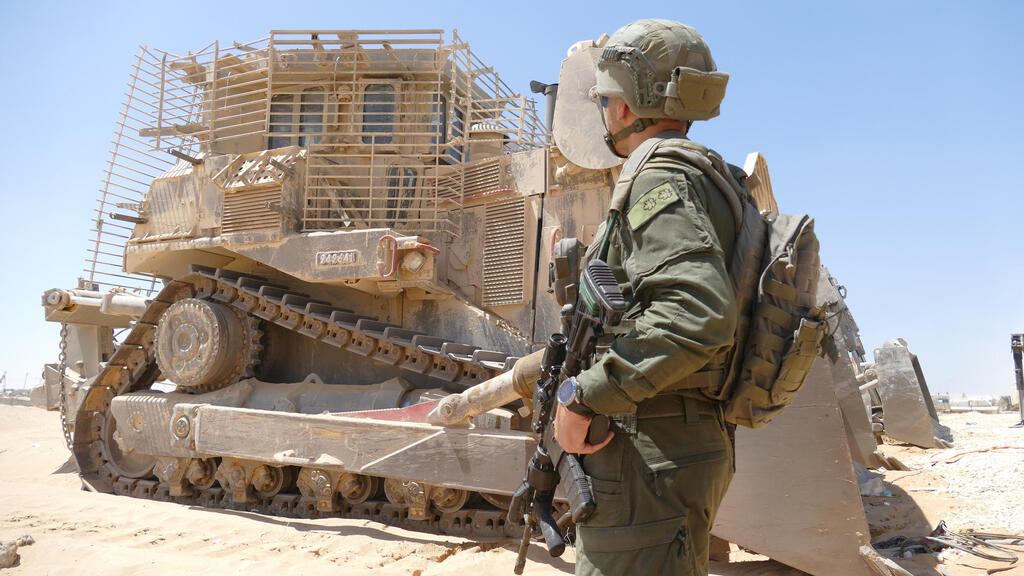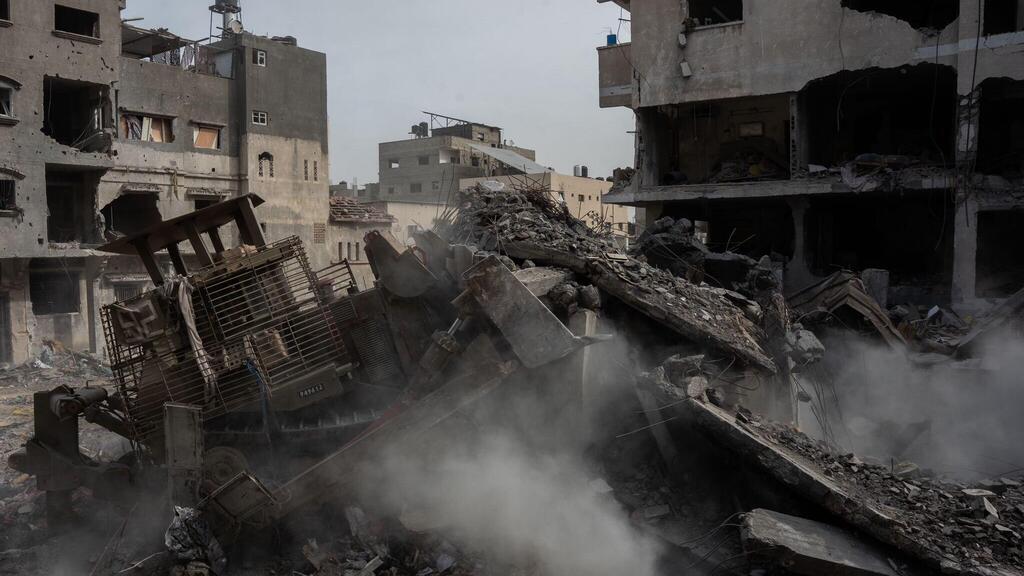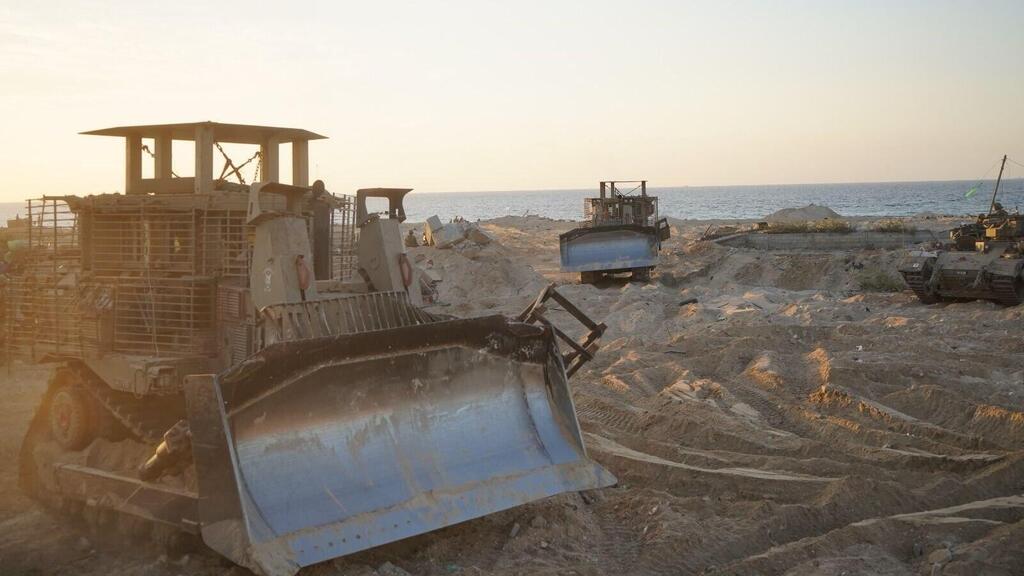Getting your Trinity Audio player ready...
In Gaza’s Philadelphi Corridor, I met a man who's in love with a D9 bulldozer, and believe me, there's no other way to describe the relationship between Warrant Officer R. and the massive metal beast standing beside us.
R. takes care of his D9 like a classic car collector, maybe with a bit more tolerance for dust. And when he talks about the monstrous steel bulldozers, he reminds me of a teenager describing his first kiss.
And this isn't just the excitement of a novice. R. is a career soldier in the IDF Combat Engineering Corps’ Yahalom unit. He's been operating this colossal machine for over 20 years, witnessing all the battlefronts where the IDF has been present firsthand.
This time, he says, it's a completely different story. "This isn't just another war," says the man who was in Lebanon, the West Bank and on the Philadelphi Corridor during the days leading up to Israel’s disengagement from Gaza in 2005. "This war is far more intense," he admits.
But despite participating in countless operations, some of which are still classified and despite having been targeted by anti-tank missiles multiple times, the real challenge in this war isn't dealing with Hamas terrorists for him.
"Taking care of the equipment is of utmost importance to me," R. says as we cross the border into the Gaza Strip. In short, some people fear explosives, while others are more concerned about the D9’s air filter and oil changes.
Charging ahead of forces
The Caterpillar D9 (or "Doobi" in IDF slang) has been manufactured by the American company Caterpillar since the 1950s. It underwent armor modifications in the IDF during the 1980s and has since served in two Lebanon wars, two intifadas in the West Bank and countless operations in the Gaza Strip.
Thanks to 8 tons of steel armor — an insignificant addition to the machine's total weight of 57 tons — it can handle almost any explosive waiting for it in the alleys of Rafah and Khan Younis.
Anti-tank missiles are countered by slat armor, thick mesh that surrounds the driver's cabin and the bent and charred remnants found in maintenance depots testify to the heavy fire these machines have endured. Small arms fire is as routine as brushing teeth and isn’t even discussed.
In the ongoing war, the D9 is at the forefront of every maneuvering force in the Gaza Strip, whether it's an armored battalion, a Givati company or elite units.
Every advance into new territory is preceded by a bulldozer reconnaissance to clear land, detect explosives, pave routes, "shake" buildings to trigger booby traps before the troops move in, build dirt embankments for protective positions and, of course, demolish structures.
Since the beginning of the war, the IDF has destroyed tens of thousands of structures in the Strip, those used for terror activities or posing a threat to its forces. Some were taken down via costly airstrikes, while others were demolished using explosives — a cheaper but riskier method for the troops.
Then there’s the D9. With a skilled operator at the controls, it can demolish a residential building within an hour, flattening it to a rubble pile no higher than a meter. This debris blocks any possibility of escape from tunnel shafts and can no longer serve as cover for Hamas terrorists.
A winning duo
Just before R. and I climb into the towering D9 cabin, I catch Lt. Col. Ran, the 162nd Division’s engineering officer, for a quick talk. This division is the only one that operated across all the areas where the IDF was active in the Gaza Strip and hasn’t left the territory even once since the start of the ground operation.
Lt. Col. Ran is less excited about the engineering machine itself and prefers to talk about the people operating it — those with the understated image of tractor drivers, who are almost never credited after yet another successful operation.
"D9 operators are tough guys with distinct characters, without exception. Think about it: it’s a duo — a driver and a vehicle commander — who work detached from their home unit and are attached to a different force that needs them each time. It takes them time to build a rapport with the unit they've joined, to trust the people and to gain confidence,” he says.
There are only a few dozen engineering equipment operators serving all the maneuvering forces in the division. It’s a small group that must meet a wide array of demands from various units.
"The engineering equipment operator, like any combatant, needs a commander to say, 'follow me,'" Lt. Col. Ran explains. "But there’s no 'follow me' here — it’s 'after them.' They drive at the front of the force with the D9 and everyone else follows. It’s a tough mental challenge, entering an alley that no one has been in before, being the first to go in. But these people are heroes, every single one of them."
One of the heroes Ran talks about is Warrant Officer R., the one with a concern for filters and a gleam in his eye, who has been on operational duty in the Gaza Strip for nearly a year, leaving behind a worried wife and three kids.
"It’s really hard on the family, but they understand the need. Since I’m a career soldier, I can’t take breaks between rotations like the reservists. My wife is a brave woman— they're the real heroes."
Over the past few weeks, the anxiety level in R.'s home has doubled as his son enlisted in the Combat Engineering Corps and will also serve as a D9 operator. For now, he’s in basic training, but he might find himself meeting his father on the front line before long.
8 km/h in third gear
R. shares all of this with me as we slowly make our way from the gathering areas to Gaza’s gates, heading toward the Philadelphi Corridor. And we’ve got plenty of time to chat — the D9 moves at a painfully slow pace of 4-5 km/h at most.
"In third gear, you can get up to 8 km/h. But if you want to take care of the machine, it's best not to do that," R. explains. It turns out that 460 horsepower is quite a lot, but you still need a bit more than that to move over 60 tons of metal on tracks at a faster pace.
After crossing the border, we switch places — R. takes the commander's position and I settle into the operator's seat. That's the official title for those who maneuver the D9 and anyone who dares call them a "driver" will, at best, get a disapproving look.
The operating mechanism of this massive bulldozer is different from any other tracked vehicle I’ve driven during my compulsory and reserve service: steering is done using two levers, but only with the left hand; the right-hand controls the enormous front blade; the gas pedal provides maximum acceleration when you release it and the machine stops when you press the pedal to the floor.
There's also a brake pedal, operated by the left foot — a technique more commonly seen on racetracks. But here, instead of seeking the apex with a distant gaze, you need to focus on the ground, looking at the grooves behind the blade to find the line of movement. And despite the D9's towering height, it’s not easy to see what’s happening outside.
The D9 lacks a suspension system, so every bump or terrain fold is felt acutely in your back and seat. The helmet is essential for anyone who doesn’t want to accidentally headbutt the turret’s iron handle.
R., having decades of experience, uses the weight of the blade, lifting and lowering it according to the terrain to stabilize the vehicle and reduce the bouncing during travel. And with a weight of 5 tons, nearly four times that of an average family car, the blade plays a critical role in balancing the bulldozer.
After a few minutes of driving along the route, R. decides to up the challenge and asks me to build a defensive dirt berm. The first step goes smoothly as I gather a decent pile of sand, but then I must reverse and continue the task.
However, since the reverse camera quickly gets covered in dust and loses its usefulness within the first few meters, reversing must be done the old-fashioned way — by turning around and looking over your shoulder.
Once we’ve had our fill of playing in the massive sandbox along the Philadelphi Corridor, I continue forward, seizing a moment when R.’s attention wanes to shift into third gear and try to "push the speed limit." But a convoy passing nearby, with tanks that look like small toys next to the D9, kicks up massive clouds of red dust, forcing us to pull over.
By this point, it’s easy to grade the D9's performance test: it fails entirely in categories like speed, features, driving comfort, and noise isolation and with an 18,000-cc engine, it won’t win any awards for fuel efficiency either.
But the cabin is relatively spacious, with a storage cabinet for drinks and snacks behind the operator’s seat (not the driver’s). The air conditioning system also scores high and no D9 would start a workday without it.
A rescue takes hours
Like any vehicle we routinely test, the D9 has gone through several generations. The first was called the N, delivering 380 horsepower; the second, the L, was larger and produced 500 horsepower.
The R model, which I drove, was introduced during the Second Intifada and delivers 460 horsepower. The T is the most advanced model, with improvements focusing less on engine power and more on technological aspects.
These include a hydrostatic operating system that allows for faster power transfer to the tracks, along with a GPS interface with sensors attached to the blade, enabling pre-set ground height data — meaning the D9 will dig until it reaches the target on its own.
There's also the Panda, the autonomous sibling of the familiar "Doobi." This is a development by the Israel Aerospace Industries’ Elta Division, equipped with cameras and sensors that replace the operator, with remote control capabilities that reduce risks to human lives.
New 'Panda' D9 in action
(Video: Nitzan Dror)
But during routine missions, Division 162’s combat engineering teams face challenges no less complex than those of the autonomous systems — like irrigation pipes and barbed wire from the agricultural areas around Rafah that get tangled in the D9's tracks, sometimes requiring professional aid from the fire department to untangle the metal mess.
At times, they’re tasked with complicated rescues that take long hours in the mud, rain or under the blazing sun. This happens when tanks or APCs get stuck on side slopes, in massive mud puddles, with broken tracks, or after hitting an explosive. In such cases, there’s only one machine capable of rescuing them — the D9.
That same trusty bulldozer, which can’t fire a single shot, has stood at the top of the IDF’s armored vehicle pyramid for decades. Alongside it, a handful of skilled operators, utterly devoted to their vehicles, wouldn't trade it for any other machine in the world.
Get the Ynetnews app on your smartphone:



